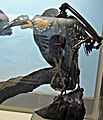New World vulture facts for kids
Quick facts for kids New World vultures |
|
|---|---|
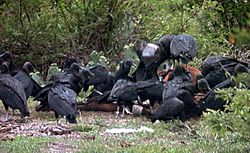 |
|
| American Black Vultures on a cow carcass | |
| Scientific classification | |
| Kingdom: | |
| Phylum: | |
| Class: | |
| Order: | |
| Family: |
Cathartidae
Lafresnaye, 1839
|
| Genera | |
|
Coragyps |
|
New World vultures are the group of vultures that are found in the Americas. They form the family Cathartidae. There are seven species in five genera. Four of the genera contain only one species each, so they are monotypic.
These are large birds of prey that feed on the meat of dead or dying animals. The name "Cathartidae" comes from the Greek word katharsis meaning to purge or make clean.
Unlike other birds of prey, they have a good sense of smell. The opening of their nostrils has a hole through from one side of the beak to the other. Some other vultures hop to move on the ground, but the New World vultures walk.
The two largest species are called condors.
Contents
Description
New World vultures are generally large, ranging in length from the lesser yellow-headed vulture at 56–61 centimeters (22–24 inches) up to the California and Andean condors, both of which can reach 120 centimeters (48 inches) in length and weigh 12 or more kilograms (26 or more pounds). Plumage is predominantly black or brown, and is sometimes marked with white. All species have featherless heads and necks. In some, this skin is brightly colored, and in the king vulture it is developed into colorful wattles and outgrowths.
All New World vultures have long, broad wings and a stiff tail, suitable for soaring. They are the best adapted to soaring of all land birds. The feet are clawed but weak and not adapted to grasping. The front toes are long with small webs at their bases. No New World vulture possesses a syrinx, the vocal organ of birds. Therefore the voice is limited to infrequent grunts and hisses.
The beak is slightly hooked and is relatively weak compared with those of other birds of prey. This is because it is adapted to tear the weak flesh of partially rotted carrion, rather than fresh meat. The nostrils are oval and are set in a soft cere. The nasal passage is perforate, not divided by a septum, so that when looking from the side, one can see through the beak. The eyes are prominent, and, unlike those of eagles, hawks, and falcons, they are not shaded by a brow bone. Members of Coragyps and Cathartes have a single incomplete row of eyelashes on the upper lid and two rows on the lower lid, while Gymnogyps, Vultur, and Sarcoramphus lack eyelashes altogether.
New World vultures have the unusual habit of urohidrosis, or defecating on their legs to cool them evaporatively. As this behavior is also present in storks, it is one of the arguments for a close relationship between the two groups.
Distribution and habitat
New World vultures are restricted to the western hemisphere. They can be found from southern Canada to South America. Most species are mainly resident, but the turkey vulture populations breeding in Canada and the northern US migrate south in the northern winter. New World vultures inhabit a large variety of habitats and ecosystems, ranging from deserts to tropical rainforests and at heights of sea level to mountain ranges, using their highly adapted sense of smell to locate carrion. These species of birds are also occasionally seen in human settlements, perhaps emerging to feed upon the food sources provided from roadkills.
Behaviour and ecology
Breeding
New World vultures and condors do not build nests, but lay eggs on bare surfaces. On average one to three eggs are laid, depending on the species. Chicks are naked on hatching and later grow down. Like most birds the parents feed the young by regurgitation. The young are altricial, fledging in 2 to 3 months.
Feeding
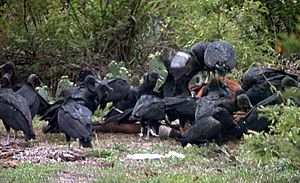
All living species of New World vultures and condors are scavengers. Their diet is overwhelmingly composed of carrion, and they are commonly seen in carcasses. Other additions to the diet include fruit (especially rotten fruit) and garbage. An unusual characteristic of the species in genus Cathartes is a highly developed sense of smell, which they use to find carrion. They locate carrion by detecting the scent of ethyl mercaptan, a gas produced by the bodies of decaying animals. The olfactory lobe of the brains in these species, which is responsible for processing smells, is particularly large compared to that of other animals. Other species, such as the American black vulture and the king vulture, have weak senses of smell and find food only by sight, sometimes by following Cathartes vultures and other scavengers.
Species
The New World vultures comprise seven species in five genera. The genera are Coragyps, Cathartes, Gymnogyps,
| Extant species | |||
|---|---|---|---|
| Common and binomial names | Image | Description | Range |
| Black vulture Coragyps atratus |
 |
South America and north to US | |
| Turkey vulture Cathartes aura |
 |
Throughout the Americas to southern Canada | |
| Lesser yellow-headed vulture Cathartes burrovianus |
 |
South America and north to Mexico | |
| Greater yellow-headed vulture Cathartes melambrotus |
 |
Amazon Basin of tropical South America | |
| California condor Gymnogyps californianus |
 |
California, and formerly widespread in the mountains of western North America. | |
| Andean condor Vultur gryphus |
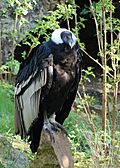 |
Andes | |
| King vulture Sarcoramphus papa |
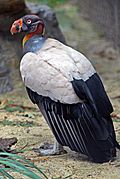 |
Southern Mexico to northern Argentina | |
Images for kids
-
Andean condor skeleton (Museum of Osteology)
See also
 In Spanish: Cathartidae para niños
In Spanish: Cathartidae para niños




